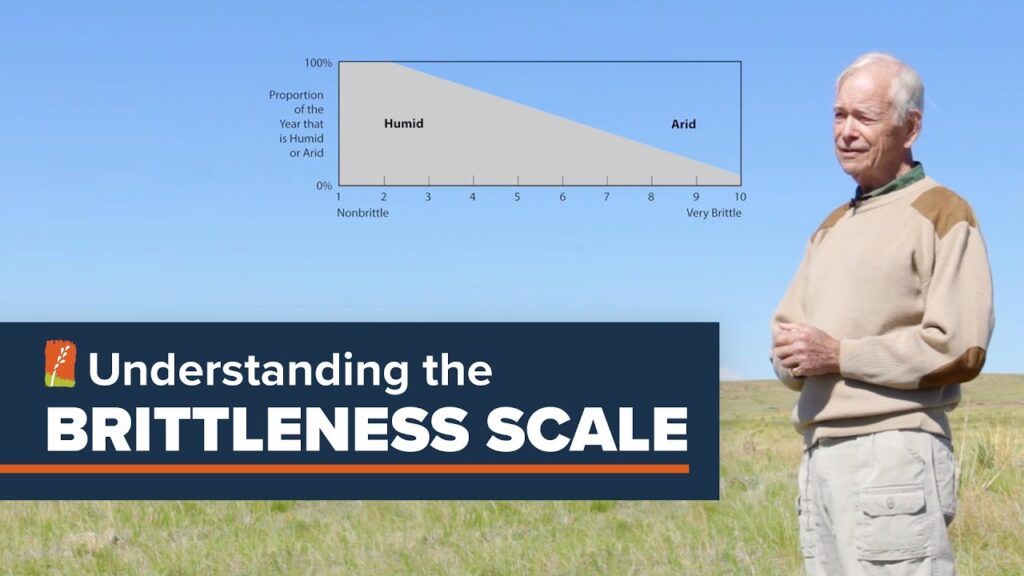Understanding the Brittleness Scale

Learn the concept of brittleness and how understanding where your region falls on the brittleness scale can affect the management options for your ranch or farm. This video shows examples on both a brittle-tending ranch and a non-brittle-tending piece of land.
Profile of good stewardship: the Rafter F Cattle Company (2001)

This case study of a ranch in New Mexico, USA by the Quivira Coalition features Rafter F Ranch—a 4,779-hectare property in San Jon, New Mexico. Net income per acre grew from $5.84 in 1984 to $22.5 in 1992.
Desertification and livestock grazing: The roles of sedentarization, mobility and rest

This paper suggests that livestock may be a solution to the problem of land degradation in arid and semiarid rangeland ecosystems. It investigates the history of desertification around the world and finds that of the many contributing factors, the singular commonality was the “prevalence of partial or total rest.”
Sustainability of holistic and conventional cattle ranching in the seasonally dry tropics of Chiapas, Mexico, Decision Making

Eighteen (18) conventional and seven (7) holistic, dual-purpose ranches were studied using three sets of sustainability metrics combining economic, social, technological, and environmental indicators. Holistic ranchers have more pasture divisions, higher grazing pressure, greater lengths of time between pasture burns, greater milk productivity, larger forest reserves, lower cow and calf mortality, purchase less hay and feed, and use less herbicides and pesticides than their conventional neighbors, with holistic ranches demonstrating superiority for nine of ten indicators. Higher soil respiration, deeper topsoil, increased earthworm presence, more tightly closed herbaceous canopies, and marginally greater forage availability were found in holistic ranches, suggesting that holistic management strategies are leading to greater ecological and economic sustainability.
Prosperity through Simplicity – The Coughlans of Tarabah

Michael and Anna Coughlin, who manage the 18,000-hectare Tarabah on the plains of southwestern New South Wales, are “among the world’s greatest harvesters of sunlight” according to Howell. The Coughlins also manage the 2,400-hectare Moonbrill property a few hours to the east in a more productive environment… all with just 2.5 full-time employees and close to 6,000 cattle. Despite large tracts of Australia’s perennials reverting to cool season annuals, the Coughlins have created the conditions for pernnials to re-establish, and in doing so the wildlife (including duck-billed platypus and echidnas) has become more abundant.
Resiliency Down Under Drought-Proofing in New South Wales

In 2006-2007, southern Australia faced historic drought conditions, with the Coughlin family’s Tarabeh property receiving 8 of the 17-inch average, and Moombril receiving 10.5 of the normal 30. They survived the drought with more cattle than they started and without buying a pound of hay. This case study details the conditions they faced and the tough decisions that were made to make it through.
The Whitten Ranch – Creating More with Less

This case study is an excerpt from Jim Howell’s 2008 book, For the Love of Land: Global Case Studies of Grazing in Nature’s Image. Following George Whitten of the San Luis valley in Colorado, Howell states “Fifteen years after taking his first Holistic Management course, he has figured out how to get by on a fraction of his former water use. He has increased the biodiversity and vigor of his irrigated meadows and hilly native rangeland to a plant mix that can thrive even in dry years.”
Rancho de la Inmaculada – Prospering in the Desert

At 2500 feet (820 meters) of elevation, the patch of desert embracing La Inmaculada is blessed with an average of 13 inches (330 mm) of annual precipitation. Since the Aguirres have been practicing Holistic Management, annual totals have ranged from 6 to 25 inches. About 50 percent comes during the summer monsoons in July and August, their main growing season. Because there is an almost total absence of cool-season grasses, winter rains do them little good in terms of grass growth, but they do add to the bank of soil moisture critical to brush green-up in the spring.
Surviving or Thriving in Drought

Analyzing ecological monitoring data from 1999 to 2007, Tony Malmberg of Twin Creek Ranch and Jim Howell assess how Twin Creek’s drought-induced management adjustments enabled them to maintain the integrity of their ecosystem processes. Malmberg also discusses his “ah-ha” moment after hearing Howell’s hypothesis that low production, brittle environments likely evolved under grazing patterns with longer (sometimes multi-year) recovery periods compared to brittle environments with higher production.
Wool Production and Biodiversity Working Together for Tim and Karen Wright: A Case Study

Lana is a 4,000-hectare sheep property in New England Tablelands region of New South Wales, Australia. Owners introduced a Holistic Management approach in mid-1990s because of degradation of pastures and poor profitability. Results achieved include: Changed from high inputs (fertilizers, sown pastures) to low input system, which reduced fertilizer use by 70%. 100% return on investment in extra fencing within 2 years. Wool yield increased from 73-74% to 78-80%. Labor costs cut in half. Maintained healthy gross margins of $200 per ha. during 2002 drought, when area had lowest rainfall on record and neighboring farmers suffered financial stress.
